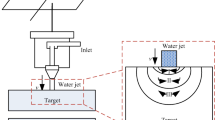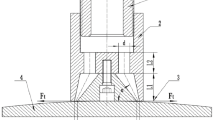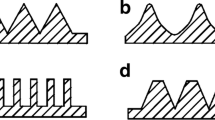Abstract
Water jet peening (WJP) is a surface enhancement technique that can use the impact pressure to induce compressive residual stress in the narrow concave area of metal components. For WJP on the inclined surface, this research reveals the impact pressure evolution and the forming mechanism of compressive residual stress field (CRSF). Mathematical models of predicting the critical inclined angle θc and the maximum water hammer pressure Pm are developed. Besides, a 3D dynamic finite element model of WJP is developed. Then, the simulation model is verified by the experimental results of the inclined surface. Moreover, the influence of parameters such as inclined angle θ, jet velocity v, and jet diameter d on θc, Pm, and CRSF is investigated by simulation. The results indicate that Pm essentially determines the CRSF, and WJP parameters indirectly affect the CRSF by changing Pm. v determines θc, and θc increases with increasing v. θ and v determine Pm, and Pm decreases with increasing θ while increases with increasing v. The magnitude and depth of CRSF decrease with increasing θ while increases with increasing v. But d only affects the depth of CRSF, which increases with increasing d.


























Similar content being viewed by others
Data availability
The raw/processed data required to reproduce these findings cannot be shared at this time as the data also forms part of an ongoing study.
Abbreviations
- WJP:
-
Water jet peening
- CRSF:
-
Compressive residual stress field
- FE:
-
Finite element
- θ:
-
Inclined angle
- θc :
-
Critical inclined angle
- Pm :
-
Maximum water hammer pressure in the contact region
- x c :
-
Length of the initial region
- d n :
-
Nozzle diameter
- d :
-
Jet diameter
- v 0 :
-
Outlet nozzle velocity
- v :
-
Jet velocity
- c :
-
Shock velocity of water
- c 0 :
-
Acoustic velocity of water
- ρ:
-
Density of water
- σsrs :
-
Surface compressive residual stress
- σmcrs :
-
Maximum compressive residual stress
- Zm :
-
Depth of maximum compressive residual stress
- Z0 :
-
Depth of CRSF
References
Soyama H (2019) Comparison between the improvements made to the fatigue strength of stainless steel by cavitation peening, water jet peening, shot peening and laser peening. J Mater Process Technol 269:65–78. https://doi.org/10.1016/j.jmatprotec.2019.01.030
Liu ZH, Yang MJ, Deng J, Zhang M, Dai QL (2020) A predictive approach to investigating effects of ultrasonic-assisted burnishing process on surface performances of shaft targets. Int J Adv Manuf Technol 106:4203–4219. https://doi.org/10.1007/s00170-019-04902-9
Soyama H (2020) Comparison between shot peening, cavitation peening, and laser peening by observation of crack initiation and crack growth in stainless steel. Metals 10:63. https://doi.org/10.3390/met10010063
Epp J, Zoch HW (2016) Comparison of alternative peening methods for the improvement of fatigue properties of case-hardened steel parts. HTM - J Heat Treat Mater 7:109–116. https://doi.org/10.3139/105.110288
He Z, Zhao S, Fu T, Chen L, Zhang Y, Zhang M, Wang P (2018) Experimental and numerical analysis of water jet peening on 6061 aluminum alloy. J Press Vessel Technol Trans ASME 140:020416. https://doi.org/10.1115/1.4039071
Zou Y, Sang Z, Wang Q, Li T, Li D, Li Y (2020) Improving the mechanical properties of 304 stainless steel using waterjet peening. Medziagotyra 26:161–167. https://doi.org/10.5755/j01.ms.26.2.21117
Lieblich M, Barriuso S, Ibáñez J, Ruiz-de-Lara L, Díaz M, Ocaña JL, Alberdi A, González-Carrasco JL (2016) On the fatigue behavior of medical Ti6Al4V roughened by grit blasting and abrasiveless waterjet peening. J Mech Behav Biomed Mater 63:390–398. https://doi.org/10.1016/j.jmbbm.2016.07.011
Azhari A, Schindler C, Godard C, Gibmeier J, Kerscher E (2016) Effect of multiple passes treatment in waterjet peening on fatigue performance. Appl Surf Sci 388:468–474. https://doi.org/10.1016/j.apsusc.2015.11.195
Muruganandhan R, Mugilvalavan M, Thirumavalavan K, Yuvaraj N (2018) Investigation of water jet peening process parameters on AL6061-T6. Surf Eng 34:330–340. https://doi.org/10.1080/02670844.2017.1394564
Srivastava M, Hloch S, Tripathi R, Kozak D, Chattopadhyaya S, Dixit AR, Foldyna J, Hvizdos P, Fides M, Adamcik P (2018) Ultrasonically generated pulsed water jet peening of austenitic stainless-steel surfaces. J Manuf Process 32:455–468. https://doi.org/10.1016/j.jmapro.2018.03.016
Srivastava M, Hloch S, Gubeljak N, Milkovic M, Chattopadhyaya S, Klich J (2019) Surface integrity and residual stress analysis of pulsed water jet peened stainless steel surfaces. Meas J Int Meas Confed 143:81–92. https://doi.org/10.1016/j.measurement.2019.04.082
Rajesh N, Veeraraghavan S, Babu NR (2004) A novel approach for modelling of water jet peening. Int J Mach Tools Manuf 44:853–863. https://doi.org/10.1016/j.ijmachtools.2004.01.010
Rajesh N, Babu NR (2006) Multidroplet impact model for prediction of residual stresses in water jet peening of materials. Mater Manuf Process 21:399–409. https://doi.org/10.1080/10426910500411736
Amri R, Laamouri A, Manchoul S, Fathallah R (2020) Transient dynamic finite element simulation for prediction of surface integrity induced by waterjet peening. Proc Inst Mech Eng Part L J Mater Des Appl 234:105–119. https://doi.org/10.1177/1464420719874389
He Z, Li C, Zhao S, Cui B, Li D, Yu H, Chen L, Fu T (2019) Mathematical model and verification of residual stress induced by water jet peening. Metals 936:1–15. https://doi.org/10.3390/met9090936
Xie J, Rittel D (2017) A two-dimensional model for metallic surface roughness resulting from pure waterjet peening. Int J Eng Sci 120:189–198. https://doi.org/10.1016/j.ijengsci.2017.08.010
Xie J, Rittel D (2017) Three-dimensional stochastic modeling of metallic surface roughness resulting from pure waterjet peening. Int J Eng Sci 120:241–253. https://doi.org/10.1016/j.ijengsci.2017.08.011
Xie J, Rittel D (2018) The effects of waterjet peening on a random-topography metallic implant surface. Eur J Mech A/Solids 71:235–244. https://doi.org/10.1016/j.euromechsol.2018.03.022
Balamurugan K, Uthayakumar M, Gowthaman S, Pandurangan R (2018) A study on the compressive residual stress due to waterjet cavitation peening. Eng Fail Anal 92:268–277. https://doi.org/10.1016/j.engfailanal.2018.05.012
Heymann FJ (1969) High-speed impact between a liquid drop and a solid surface. J Appl Phys 40:5113–5122. https://doi.org/10.1063/1.1657361
Dyment A (2015) Compressible liquid impact against a rigid body. J Fluids Eng Trans ASME 137:031102. https://doi.org/10.1115/1.4028597
Huang F, Li S, Zhao Y, Liu Y (2018) Study on lateral jetting range during an arc-curved jet impacting nonplanar solid surfaces. J Fluids Eng Trans ASME 140:101201. https://doi.org/10.1115/1.4039945
Huang F, Li S, Yong L (2018) Research on the impacting pressures of water jet impacting the irregular targets based on the ALE algorithm. J Hunan Univ Sci Technol Sci Ed 33:8–15. https://doi.org/10.13582/j.cnki.1672-9102.2018.03.002
Cho JR (2015) Simulation of the repeated waterdrop impact onto the AL6061-T6. J Mech Sci Technol 29:3679–3683. https://doi.org/10.1007/s12206-015-0812-8
He Z, Yu H, Zhao S, Xing J, Li D, Li C, Chen L, Wang S (2020) An experimental and numerical analysis of water jet peening of Al6061-T6. Int J Adv Manuf Technol 107:3833–3845. https://doi.org/10.1007/s00170-020-05282-1
Acknowledgements
The authors thank Ph.D. Zhenhui Sun and Dongliang Liu for their help in preparing this paper. Especially, Ph.D. Sun gave great help in the experiment.
Funding
This work was supported by the National Natural Science Foundation of China [51305408].
Author information
Authors and Affiliations
Contributions
Shusen Zhao performed the experiments, made the simulation, and wrote the manuscript, while Zhanshu He and Yanmin Li contributed to the conception of the study and helped perform the analysis with constructive discussions.
Corresponding author
Ethics declarations
Ethics approval
Not applicable
Consent to participate
Not applicable
Consent for publication
Not applicable
Additional information
Publisher’s note
Springer Nature remains neutral with regard to jurisdictional claims in published maps and institutional affiliations.
Rights and permissions
About this article
Cite this article
Zhao, S., He, Z. & Li, Y. Investigation on impact pressure and residual stress of water jet peening on AL6061-T6 with an inclined surface. Int J Adv Manuf Technol 114, 1131–1153 (2021). https://doi.org/10.1007/s00170-021-06923-9
Received:
Accepted:
Published:
Issue Date:
DOI: https://doi.org/10.1007/s00170-021-06923-9




